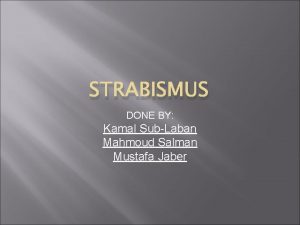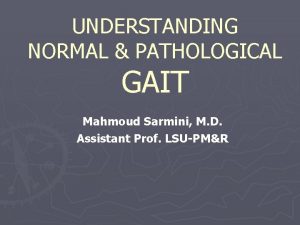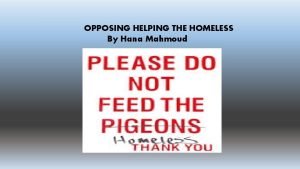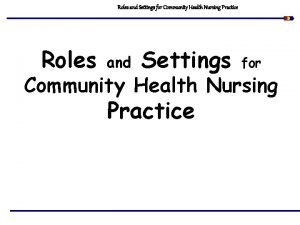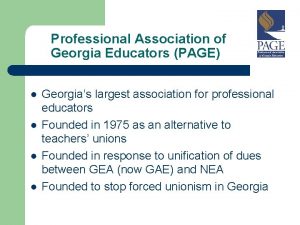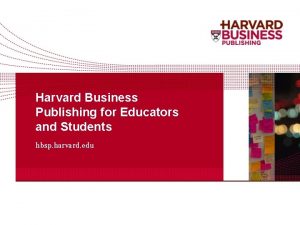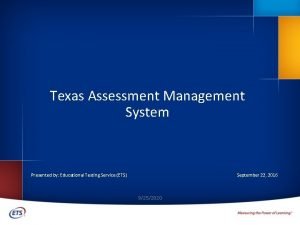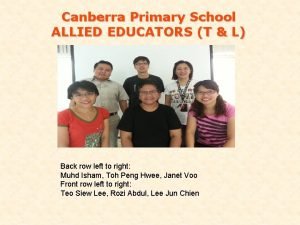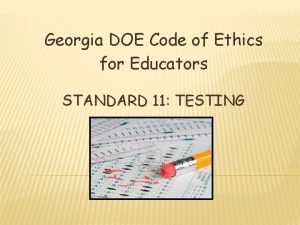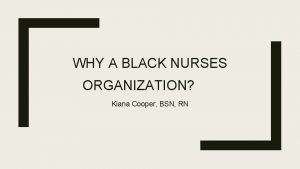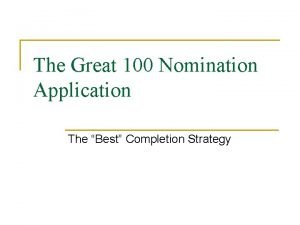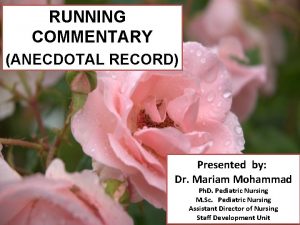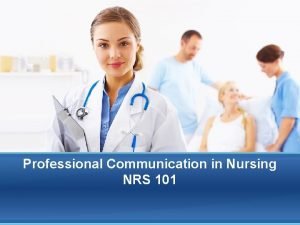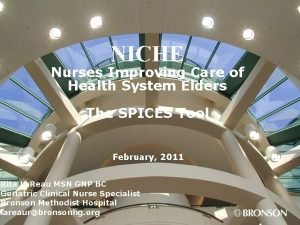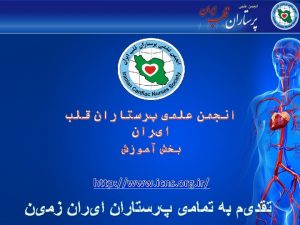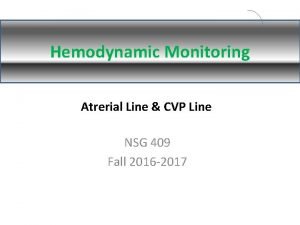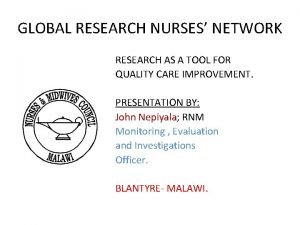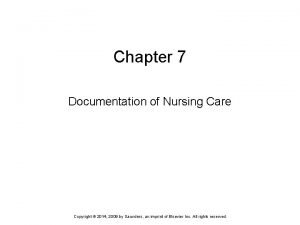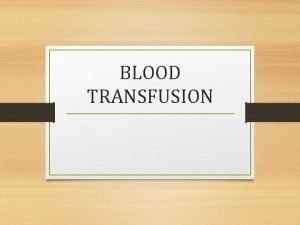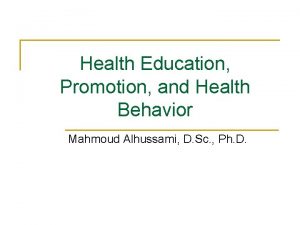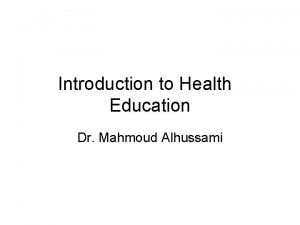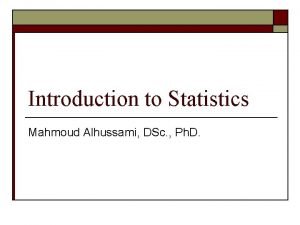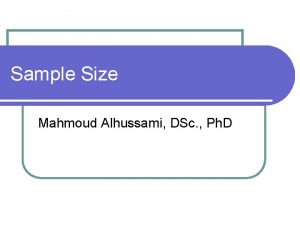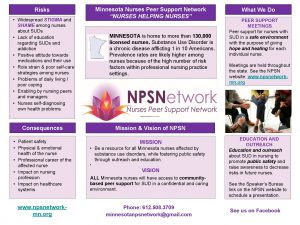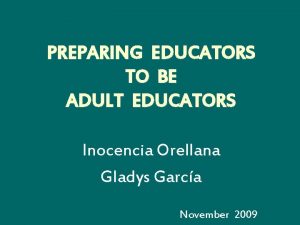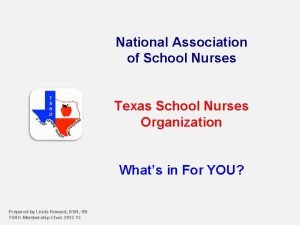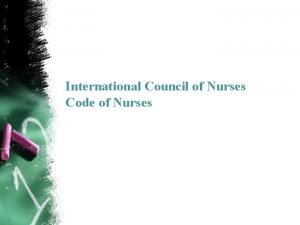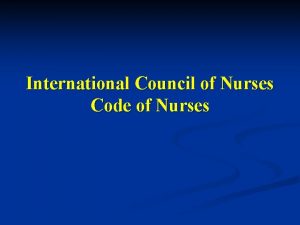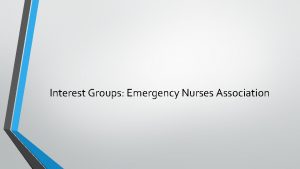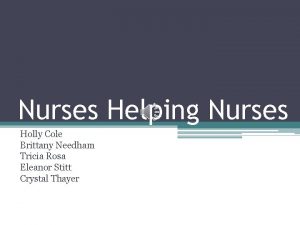Nurses as Health Educators Dr Mahmoud Alhussami Nurses






































- Slides: 38

Nurses as Health Educators Dr. Mahmoud Alhussami

Nurses as Educator Needs to: l l l Identify the learning needs of patients and relatives. Identify the learning opportunities available for individual and or groups in the clinical setting. Select and use suitable teaching methods and materials. Develop patient education within (a given) care setting. Evaluate patient education programs at a level which will allow for improvement of personal performance as a health teacher.

In teaching for health the nurse may help to identify and solve health related problems by: l l l l Informing Advising Helping with the acquisition of skills Assisting with the process of clarifying beliefs, feelings and values. Enabling the adaptation of lifestyle. Promoting change in the structures and organizations which influence health status. Providing a model of values and behavior related to health.

Teaching Learning Principles l l l Teaching. The process of helping or enabling another person to learn. It encompasses a variety of activities, these include, and giving information or advice, helping people clarify their thinking, express their feelings, identify options or develop new skills. Learning. A basic human activity, essential to survival. It is demonstrated by a change in behavior. There is an essential relationship between teaching and learning, it is possible to learn without being taught but it is not possible to teach without learning taking place. That is, if no learning has occurred, then teaching did not occur either.

The teaching learning process l l Identify and focus on specific learning needs (assessment). Plan how to meet those needs. Implement—put the plans into action. Evaluation.

Steps in assessment of learning needs: l Identify the learner l l l Collect data on the learner (assess learning needs) l l l Actively engaging learners in defining their own problems and needs allow them to learn because they have an investment in planning for a program. Choose the right setting l l Determine characteristics need of the population by exploring typical health problems or issues of interest to that population. Include the learner as a source of information l l Who is the audience? If more than one learner, are their needs congruent or diverse? Establishing a trusting environment will help learners feel a sense of security in confiding information, believes their concern are taken seriously and feel respected. Involve members of the health care teams. Prioritized needs.

Methods to assess learning needs from learner: l l l Informal conversation—learning needs can be discovered during any conversation between the nurse and family. The nurse must rely on active listening. Structured interviews—the nurse asks the learner direct and often predetermined questions to gather information about learning needs. Observations

Barriers to identification of needs: l Teacher (barriers to perception of client's needs) l l l l Does not listen or respond to client's question. Lack of knowledge to deal with question. Has insufficient information about client. Discourages client participation to maintain control. Lacks time due to poor ward organization or inadequate staffing. Lack of confidence. Learner (Barriers to expression of needs) l l l l Reluctant to ask questions Perceive ward to busy to seek attention. Lacks language to request technical information Perceives professionals only helpers, not teacher or informants. Adopt passive role readily. Not ready or motivated to participate. Convinced by previous experiences that expression of needs is not welcomed. Does not consider health teaching part of the nurse's role.

Prioritized needs

Factors in teaching learning Situation Environment Space Noise Furniture Time Material Resources Support from the system Expectations Learner Motivation Capacities Energy Culture and age Intelligence and skills Emotional and physical state Values and experience Learning style Teacher Motivation Capacities Knowledge Energy Beliefs and Values Communication Skills Selection of methods and materials Teaching style

Educational Objectives l l Goal—the final outcome of what is achieved at the end of teaching learning process. Broad in nature and serve as a long term targets for both the learner and teacher. Objective—specific, single, one-dimensional behavior. Short term in nature and should be achievable at the conclusion of teaching sessions or within a matter of few days.

Characteristics of goals and objectives l l l Objective must be achieved before the goal can be reached Goals and objectives must be observable and measurable to be able to determine if they have been met by the learner. Objectives are derived from the goal and must be consistent with and related to that goal. Objectives and goals must also be clearly written, realistic and learner centered. Objectives and goals must be directed to what the learner is expected to be able to do, not what the teacher is expected to teach. together objectives and goals forms a map giving directions (objectives) as how to arrive at particular destination (goals)

Example: l l l Goal: the group of diabetic patient will learn to manage diabetes after one week Objectives: After 4 hours of discussion the group of diabetic patient will be able to list a diabetic diet planned menu for 2 days. After watching the demonstration on self glucose monitoring the group of diabetic patient will be able to do the correct procedure for self glucose monitoring. After watching the demonstration on self insulin administration the group of diabetic patient will be able to correctly administer insulin. On completing the reading materials provided on diabetic exercise regimen the group of diabetic patient will be able to list down 3 out of 5 importance of exercise regimen for diabetic.

Objectives l Educational or instructional objectives l l Use to identify the intended outcomes of the education process, whether in reference to an aspect of a program or total program of the study. Behavioral or learning objectives l Action oriented rather than content oriented and learner centered rather than teacher centered.

Advantages of behavioral objectives: l l l l Helps to keep educators thinking on target and learner centered. Communicates to others, both learners and health care team members alike, what is planned for teaching and learning. Helps learner understand of what is expected of them, so they can keep track of their progress. Forces the educator to organize educational materials so as not to get lost in content and forget the learner's role in the process. Tailors teaching to the learner's particular needs. Serves as a guidepost for teacher evaluation and documentation of success or failure. Orient the teacher and learner to the specific end of instruction. Make it easy for the learner to actually visualize performing the required action.

Three important characteristics of writing concise and useful behavioral objectives: l l l Performance—describe what the learner is expected to be able to do or perform to demonstrate the kinds of behaviors the teacher will accept as evidence that objectives have been achieved. Conditions—describe the testing situation or constraints under which the behavior will be observed or the performance is expected to occur. Criterion—describes how well or with what accuracy the learner must be able to perform for the behavior to be considered acceptable.

Steps in writing behavioral objectives: l l l Identify the testing situation (condition) State the learner (who) and the learners behavior (performance) Conclude by stating the performance level (criterion)

Example: well-written objectives l l l "Following a 30 minutes teaching session on hypoglycemia (condition), Mr. Ali will be able to identify (performance) three out of four major symptoms of low blood sugar (criterion). After watching the demonstration on self glucose monitoring the group of diabetic patient will be able to do the correct procedure for self glucose monitoring. Following a class on hypertension, the patient will be able to state three out of four causes of high blood pressure.

Common mistakes when writing objectives: l l l To describe what the instructor rather than the learner is expected to do. To include more than one expected behavior in a single objective (avoid using the compound word and—e. g. , the patient will select and prepare). To forget to include all three components of condition, performance, criterion. To use terms for performance that are subject to many interpretations, not action oriented and difficult to measure. To write an objective that is unattainable given the ability of the learner. To write objective that do not relate to the stated goal.

Example: poor written objectives l l l the patient will be able to prepare a menu using low salt foods (condition and criterion missing) given a list of exercises to relieve low back pain, the patient will understand how to control low back pain (performance not stated in measurable terms, criterion missing) to demonstrate crutch walking postoperatively to the patient (teacher-centered)

Taxonomy of objectives according to learning domains l l Taxonomy—a mechanism used to categorize things according to their relationship to one another. Taxonomy of behavioral objectives l l l develop by bloom et al. (1956) A tool for systematically classifying behavioral objectives. It became widely accepted as a standard aid for planning as well as evaluating learning, it is divided into three learning domains.

Three learning domains: l l l Cognitive domain. The "thinking domain". Refers to acquisition of information through the learner's intellectual abilities, mental capacities, and thinking processes. Affective domain. The "feeling" domain. Learning in this domain involves an increasing internalization or commitment to feelings expressed as emotions, interests, attitudes, values and appreciations. It is divided into categories that specify the degree of a person's depth of emotional response to tasks. Psychomotor domain. The "skills" domain. Learning in this domain involves acquiring fine and gross motor abilities with increasing complexity of neuromuscular coordination to carry out physical movement such as walking, handwriting, manipulation of equipment, or carrying out procedure. Psychomotor skills are easy to identify and measure because they include primarily movement-oriented activities that are relatively observable.

Levels of Cognitive Domain l l l Knowledge—the ability of the learner to memorize, recall, define, recognize or identify specific information, such as facts, rules, principles presented during instruction Comprehension—ability of the learner to demonstrate an understanding or apprehension of what is being communicated by translating it into a different form or recognizing it in a translated form. e. g. , grasping an idea by defining or summarizing it in his own words. (knowledge is prerequisite behavior) Application—ability of the learner to use ideas, principles, abstractions or theories in particular and concrete situations, such as figuring, writing, reading or handling equipment (knowledge and comprehension are prerequisites behavior)

Levels of Cognitive Domain l l l Analysis—ability of the learner to recognize and structure information by breaking it down into its constituent part and specifying the relationship between parts. (knowledge, comprehension and application are prerequisites behavior) Synthesis—ability of the learner to put together parts and elements into a unified whole by creating a unique product that is written, oral, or pictorial. (knowledge, comprehension, application and analysis are prerequisites behavior) Evaluation—ability of the learner to judge the value of something, such as an essay, design, or action by applying appropriate standards or criteria. (knowledge, comprehension, application, analysis and synthesis are prerequisites behavior)

Examples of behavioral objectives according to cognitive domain l Analysis level: l l After reading handouts provided by the nurse educator, the family member will calculate the correct n number of total grams of protein included on average per day in the family diet. Synthesis level: l Given a sample list of foods, the patient will devise a menu to include foods from the food groups (dairy, meat, vegetables, fruits and grains) in the recommended amount of daily intake.

Teaching methods in cognitive level: l l Lecture One-to-one instruction Computer assisted instruction the use of verbal, written, and visual tools are all particularly successful in supplementing the teaching methods to help learner master cognitive contents

Levels of Affective Domain (Categories): l l l Receiving—ability of the learner to show awareness of an idea or fact or a consciousness of a situation or event in the environment. It represents willingness to selectively attend to or focus on data or to receive a stimulus. Responding—ability of the learner to respond to experience, at first obediently and later willingly and with satisfaction. . . (receiving is a prerequisite behavior) Valuing—ability of the learner to regard or accept the worth of a theory, idea or event, demonstrating sufficient commitment or preference to be identified with some experience seen as having value and a definite willingness and desire to act to further that value. (receiving and responding are a prerequisites behavior)

Levels of Affective Domain (Categories): l l Organization—ability of the learner to organize, classify and prioritize values by integrating a new value into general set of values, to determine interrelationships of values, and to harmoniously establish some as dominant and pervasive. (receiving, responding and valuing are a prerequisites behavior) Characterization—ability of the learner to integrate values into a total philosophy or world view, showing firm commitment and consistency of responses to the values by generalizing certain experiences into a value system or attitude clusters. (receiving, responding, valuing and organization are a prerequisites behavior)

Examples of behavioral objectives in affective domain: l Receiving level: l l Characterization level: l l During a group discussion session, the patient will admit to any fears he may have about needing to undergo a repeat angioplasty. Following a series of in-service education session, the staff nurse will display consistent interest in maintaining strict hand washing technique to control the spread of nosocomial infections to patients in the hospital. Responding level: l At the end of one-to-one instruction, the child will verbalize feelings of confidence in managing her asthma using the peak flow tracking chart.

Teaching methods used in the affective domain: l l l Questioning Case study Role playing Stimulation gaming—a process games, controlled by participants and with flexible rules. Group discussion

The affective domain encompasses three levels that govern attitude and feelings: l l l Intrapersonal level—personal perception of one's own self, such as self concept, self awareness and self acceptance. Interpersonal level—perspective of self in relation to other individuals. Extrapersonal level—perception of others as established groups.

Levels of Psychomotor Domain: l l Perception—ability of the client to show sensory awareness of objects or cues associated with some tasks to be performed. It involves reading directions or observing a process with attention to steps or techniques inherent in a process. Set—ability of the learner to exhibit readiness to take a particular kind of action such as following directions, through expression of willingness, sensory attending or body language favorable to performing a motor act. (perception is a prerequisites behavior) Guided response—ability of the learner to exert effort via overt actions under the guidance of an instructor to imitate an observed behavior with conscious awareness of effort. (perception and set are prerequisites behaviors) Mechanism—ability of the learner to repeatedly perform steps of desired skills with a certain degree of confidence, indicating mastery to the extent that some or all aspect of the process becomes habitual. (perception, set and guided response are prerequisites behaviors)

Levels of Psychomotor Domain: l l l Complex overt response—ability of the learner to automatically perform a complex motor act with independence and a high degree of skill without hesitation and with minimum expenditure of time and energy. Performance of an entire complex behavior without the need to attend to details. (perception, set, guided response and mechanism are prerequisites behaviors) Adaptation—ability of the learner to make modifications or adaptations in a motor process to suit the individual or various situations, indicating mastery of highly developed movements that can be suited in variety of conditions. ) (perception, set, guided response, mechanism and complex overt response are prerequisites behaviors) Origination—ability of the learner to create new motor acts, such as novel ways of manipulating objects or materials, as a result of understanding of a skill and developed ability to perform skills. (perception, set, guided response, mechanism, complex overt response and adaptation are prerequisites behaviors)

Examples of behavioral objectives in the psychomotor domain: l Guided response level: l l After watching a 15 -minute video on the procedure for self examination of the breast, the client will perform on a model with 100% accuracy. Set level: l Following demonstration of proper crutch walking, the patient will attempt to crutch walk using the correct three point gait technique.

Teaching methods use in psychomotor domain: l Demonstration and return demonstration

Factors that affect the individual to learn new skills: l l l Readiness to learn—the motivation to learn affects the degree of perseverance exhibited by the learner in working toward mastery of a skill. Past experience—if the learner is familiar with equipments or techniques similar to that being needed to learn a new skill, then mastery of the new skill may be achieved at a faster rate. Health status—illness state or other physical or emotional impairments in the learner may impact on the time it takes to acquire or successfully master a skill.

Factors that affect the individual to learn new skills: l l Environmental stimuli—depending on the type and level stimuli as well as the learning style (degree of tolerance to a certain stimuli), distraction in the immediate surroundings may interfere with skills acquisition. Anxiety level—ability to concentrate can be highly affected by how anxious someone feels. Anxiety levels interfere with coordination, steadiness, fine muscle movements and concentration levels when performing complex skills. Developmental stage—certainly a young child's fine and gross motor skills as well as cognitive abilities are at different level than those of adult. Practice session length—during the beginning stages of learning a motor skills, short and carefully planned practice session and frequent rest periods are valuable techniques to help increase the rate and success of learning.

Thank You
 Measurement and evaluation for health educators
Measurement and evaluation for health educators Mahmoud abdelfattah age
Mahmoud abdelfattah age Passport mahmoud darwish
Passport mahmoud darwish Salman mustafa
Salman mustafa Mahmoud arafa
Mahmoud arafa Boudarene mahmoud
Boudarene mahmoud Mahmoud sarmini md
Mahmoud sarmini md Adp antagonist drugs
Adp antagonist drugs Mahmoud khattab md
Mahmoud khattab md Hana mahmoud
Hana mahmoud Function of community health nurse
Function of community health nurse Missouri educators trust
Missouri educators trust Professional association of georgia educators
Professional association of georgia educators Nyhre
Nyhre Hbsp coursepack
Hbsp coursepack Texas assessment management
Texas assessment management Lean innovation educators summit
Lean innovation educators summit Georgia code of ethics for educators
Georgia code of ethics for educators College of allied educators
College of allied educators Georgia code of ethics for educators
Georgia code of ethics for educators Earth educators rendezvous
Earth educators rendezvous Kiana cooper
Kiana cooper Great 100 nurses nomination examples
Great 100 nurses nomination examples Anecdotal reports in nursing
Anecdotal reports in nursing Quality and safety education for nurses
Quality and safety education for nurses Nurses note example
Nurses note example Nurses improving care for healthsystem elders
Nurses improving care for healthsystem elders 6 key priorities in health
6 key priorities in health National association of catholic nurses
National association of catholic nurses Metric conversion table nursing
Metric conversion table nursing Phlebostatic axis
Phlebostatic axis Phlebostatic point
Phlebostatic point Global research nurses
Global research nurses Fall prevention quiz
Fall prevention quiz Operating room nurses association
Operating room nurses association Pie documentation nursing
Pie documentation nursing Nurses notes for blood transfusion
Nurses notes for blood transfusion Hospital admission procedure
Hospital admission procedure Reflective discussion
Reflective discussion



